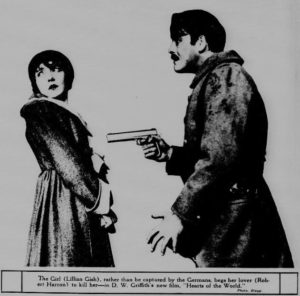The First Lady of American Cinema

In honor of Women’s History Month, today’s post features Lillian Diana Gish, a native Ohioan whose career as an actress, director and writer spanned most of the 20th century, from around 1899 through 1987. She was born in Springfield, Ohio, on October 14, 1893, to Mary Robinson McConnell and James Leigh Gish. Her family soon moved to Dayton, where her sister, Dorothy Elizabeth (also an actress, director and writer), was born in 1898.Eventually theymoved to Baltimore, Maryland, and then to New York City. In order to support herself and her two daughters after James Gish left the family, Mary Gish joined an acting troupe known as Proctor’s Stock Company. Soon Lillian and Dorothy joined the groupas there was a need for child actresses and their wages could helpsupport the family.

Gish’s acting debut brought her back to Ohio where she performed in the play In Convict’s Stripes inRisingsun, a small community in northwest Ohio. After the performance season, her family temporarily moved to Massillon, Ohio, for the summer. Theylivedwith Gish’s aunt (her mother’s sister) until returning to New York and the theater. The Gish sisters certainly had an unconventional childhood, at times living apart from their mother and each other. Theystill wentto church when they could (theywere baptized in Cleveland), and their mother did her best to educate them while on the road. In her autobiography, Gishrecalls, “We had our lessons in our dressing rooms, stations, rented rooms. If we were all together, Mother would arrange the most interesting outings that combined lessons with sightseeing. […] Mother always carried a history book under her arm so that she could read to us and answer our questions” (p. 1).
In 1912, Gish’s career moved from the stage to the cinema. Her first movie role was in An Unseen Enemy, a film directed by D.W. Griffith, with whom Gishwould work multiple times over the course of her career–including a leading role in his now-infamous 1915 film, The Birth of a Nation. Her early cinema career and fame is documented by historic newspapers, such as the ChicagoDay Book which reported that Gishmade “[s]uch rapid strides…in her new field of endeavor that she soon gained fame as one of the greatest emotional actresses of the silent drama” (March 22, 1916, Image 10, col. 1). As a silent film actress, shewas known for her expressiveness and would often suffer for her art. In performing the scene for the movie Way Down East in which her character faints on an ice floe, for example, Gishlet her hand and hair trail in the water. She spent at least twenty minutes a day for three weeks on the ice, later writing in her autobiography, “After a while, my hair froze, and I felt as if my hand were in a flame. To this day, it aches if I am out in the cold for very long” (p. 233).

Eventually Gishmoved from silent film to sound film (also known as talkies), although she was initially not as successful in these roles as she had been in silent film where she portrayed wholesome and suffering yet strong heroines. During the 1930s and early 1940s, she mostly performed on stage, but by the mid-1940s through the end of her career in 1987, she was regularly acting in movies and on television. In addition to acting, Gishdirected one film in 1920, Remodeling Her Husband, which starred her sister, Dorothy. She was also an advocate for film preservation and silent films in general. She died in 1993, a few months shy of her 100th birthday.
Lillian Gish is still considered the greatest actress of the silent era and one of greatest in cinema history: she is the “First Lady of American Cinema.” Her acting technique, commitment to her craft and remarkable career have earned her a number of accolades: the George Eastman Award in 1955; an honorary Academy Award in 1971; Kennedy Center Honors in 1982; and an American Film Institute Life Achievement Award in 1984. Ohio has also commemorated Lillian Gish’s career and contributions to American film: Bowling Green State University honors the careers of both her and her sister with The Gish Film Theater and Gallery, dedicated in 1976, and she was inducted into the Ohio Women’s Hall of Fame in 1980.
Although Gish did not spend a long time in Ohio overall, she had fond and pleasant memories of her time here, and those Ohio sights, experiences and even smells were an important part of her development. Ohio women, both better and lesser-known, have made many contributions to our local, state, national and international culture and history. As we celebrate Women’s History Month this March, take a moment to explore Ohio Memory andChronicling Americato learn more about some of these amazing people, whose lives and works have shaped the world we know today.
Further reading: Lillian Gish: The Movies, Mr. Griffith and Me by Lillian Gish with Ann Pinchot (1969).
Thanks to Jenni Salamon, Coordinator for the Ohio Digital Newspaper Program, for this week’s post!



Leave a Reply
You must be logged in to post a comment.